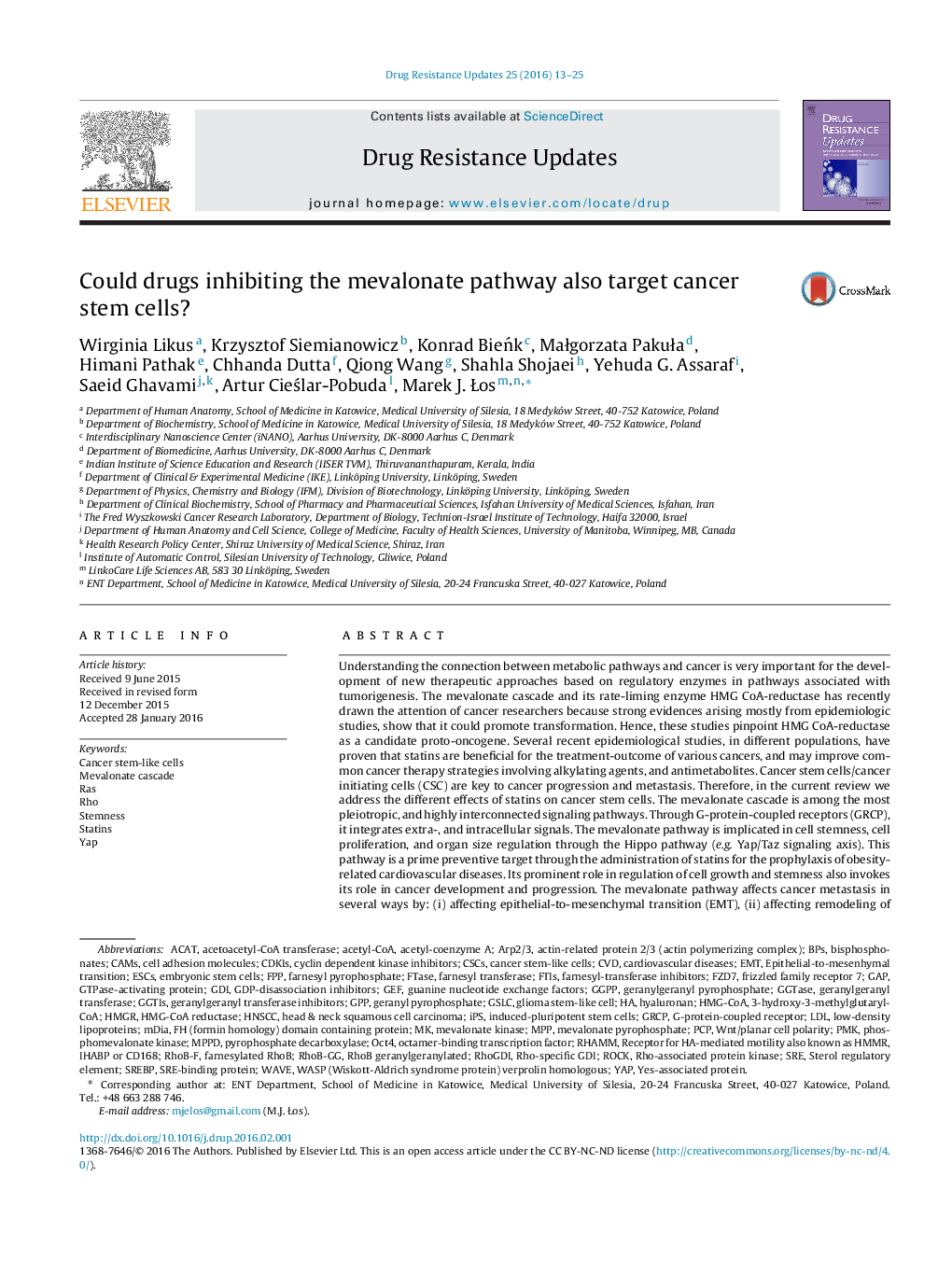| Article ID | Journal | Published Year | Pages | File Type |
|---|---|---|---|---|
| 8436713 | Drug Resistance Updates | 2016 | 13 Pages |
Abstract
Understanding the connection between metabolic pathways and cancer is very important for the development of new therapeutic approaches based on regulatory enzymes in pathways associated with tumorigenesis. The mevalonate cascade and its rate-liming enzyme HMG CoA-reductase has recently drawn the attention of cancer researchers because strong evidences arising mostly from epidemiologic studies, show that it could promote transformation. Hence, these studies pinpoint HMG CoA-reductase as a candidate proto-oncogene. Several recent epidemiological studies, in different populations, have proven that statins are beneficial for the treatment-outcome of various cancers, and may improve common cancer therapy strategies involving alkylating agents, and antimetabolites. Cancer stem cells/cancer initiating cells (CSC) are key to cancer progression and metastasis. Therefore, in the current review we address the different effects of statins on cancer stem cells. The mevalonate cascade is among the most pleiotropic, and highly interconnected signaling pathways. Through G-protein-coupled receptors (GRCP), it integrates extra-, and intracellular signals. The mevalonate pathway is implicated in cell stemness, cell proliferation, and organ size regulation through the Hippo pathway (e.g. Yap/Taz signaling axis). This pathway is a prime preventive target through the administration of statins for the prophylaxis of obesity-related cardiovascular diseases. Its prominent role in regulation of cell growth and stemness also invokes its role in cancer development and progression. The mevalonate pathway affects cancer metastasis in several ways by: (i) affecting epithelial-to-mesenchymal transition (EMT), (ii) affecting remodeling of the cytoskeleton as well as cell motility, (iii) affecting cell polarity (non-canonical Wnt/planar pathway), and (iv) modulation of mesenchymal-to-epithelial transition (MET). Herein we provide an overview of the mevalonate signaling network. We then briefly highlight diverse functions of various elements of this mevalonate pathway. We further discuss in detail the role of elements of the mevalonate cascade in stemness, carcinogenesis, cancer progression, metastasis and maintenance of cancer stem cells.
Keywords
Oct4PMKRASACATMPPDBPSFTIsGGPPmDiaInduced-pluripotent stem cellsHMG-CoASREFZD7GEFSREBPESCsHNSCCRhoGDIFTaseGGTasePCPGDIMPPFPPHMGRCSCsGPPCDKIs3-Hydroxy-3-methylglutaryl-CoAArp2/3CAMsG-protein-coupled receptorHMG-CoA reductaseiPSStatinsacetyl-coenzyme AAcetyl-CoAYAPStemnessBisphosphonatesCardiovascular diseasesEMTRhammCVDRhocancer stem-like cellsEmbryonic stem cellsGAPsterol regulatory elementGuanine nucleotide exchange factorsfarnesyl pyrophosphatefarnesyl transferasePhosphomevalonate kinaseLDLlow-density lipoproteinscyclin dependent kinase inhibitorsWavecell adhesion moleculesHyaluronanGTPase-activating proteinyes-associated proteinRho-associated protein kinasegeranyl pyrophosphategeranylgeranyl pyrophosphateMevalonate Kinasegeranylgeranyl transferaseRock
Related Topics
Life Sciences
Biochemistry, Genetics and Molecular Biology
Cancer Research
Authors
Wirginia Likus, Krzysztof Siemianowicz, Konrad BieÅk, MaÅgorzata PakuÅa, Himani Pathak, Chhanda Dutta, Qiong Wang, Shahla Shojaei, Yehuda G. Assaraf, Saeid Ghavami, Artur CieÅlar-Pobuda, Marek J. Åos,
